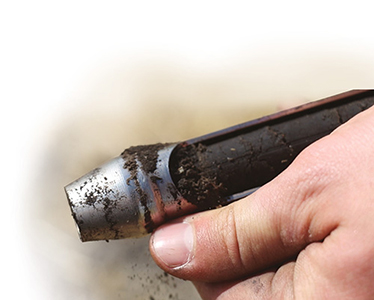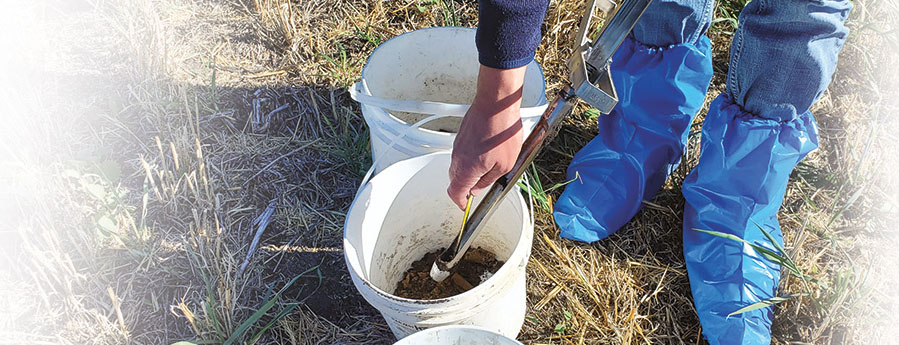Three fertilizer tests to lower your risk
Here are three low-cost, low-risk tests to provide valuable new observations on yield potential, major hidden soil nutrient issues and right rates.
Targeted soil samples
The most common soil sampling practice is to collect one composite sample per field. An appropriate composite is based on 12-20 sub-samples or “cores” from the most productive areas. However, by avoiding low-producing areas, you may be missing critical insight to boost yield potential in those areas. With a second (or third) targeted compost, you may discover something that could be solved, or at least improved, with some targeted management.
COST: Around $100 per field to collect and analyze one targeted soil test.
DIFFICULTY: Easy

| Primary Composite | Targeted sample – problem area | |
|---|---|---|
| Nitrogen (NO3-N), lb./ac. | 106 | 50 |
| Phosphorus (P), lb./ac. | 405 | 149 |
| Potassium (K), lb./ac. | 1,900 | 298 |
| Sulphur (SO4-S), lb./ac. | 40 | 38 |
| Organic matter, % | 4.5 | 6.5 |
| pH | 6 | 6.5 |
| Salinity (dS/m) | 0.3 | 0.4 |
Lyle Cowell, senior agronomist with Nutrien, provides this real example where he sampled the usual higher-yielding area and targeted a poor-yielding area in the same field. “A sample site in the poor area of a field may be of as much or more value than a composite sample from the good areas of a field,” Cowell says “The composite sample missed that a potential huge part of the field was potassium deficient and that a targeted high rate of potassium in this area could greatly improve the yield potential.”
Nitrogen strips
Whatever nitrogen rate you use, try a few strips with 125 or 150 per cent of that rate. Compare yields with the combine yield monitor or, ideally, carts with scales. Results may support existing practices or identify a potential adjustment. If yields do not increase in the strips, perhaps another nutrient is limiting. Or perhaps weather and soil conditions simply don’t support higher yields. All of these are valuable learnings.
COST: Urea in Western Canada as of July 2024 was around $650 per tonne, or 64¢ per pound of actual N. So a 100 lb./ac. rate of actual nitrogen (applied as urea) would be $64 per acre. An extra 50 lb./ac. (150 per cent rate) would add $32 per acre. A 60-foot drill going the full length of a quarter section (2,640 feet) covers 3.6 acres, including the headland area. So $32 multiplied by 3.6 acres adds up to $115 per strip for the 50 per cent extra nitrogen. If that extra nitrogen increases yields by two or three bushels per acre in that strip, the experiment will break even.
DIFFICULTY: If applying nitrogen on its own (not in a blend), adjusting rates is relatively easy. Curtis de Gooijer with Bourgault says their newer systems are controlled in the cab and “it’s as simple as typing in a new rate as you are seeding.” Kris Cherewyk with Väderstad says, “Adjusting nitrogen rates with the Väderstad iCon wireless control system is quick and simple.”
Tissue tests
This past summer, a northern Saskatchewan agronomist went to a canola field to check on “textbook sulphur deficiency.” The applied sulphur rate seemed reasonable, but with a wet May and June, sulphur likely leached down. Saturated soils early in the season also meant relatively shallow crop rooting depth. Just to be sure, the agronomist ran a tissue test.
The recommended practice with a tissue test is to also submit separate soil samples from the area around the sick and healthy plants. This can indicate whether the tissue test results are due to an uptake issue (too much water for proper root function) or an actual soil shortage.
Tissue results in this case showed adequate nutrients, including sulphur, in the healthy leaves and acute sulphur deficiency in the sick leaves. The agronomist was right. A localized sulphur top dress could help if soils were also deficient.
COST: A complete plant tissue test analysis (macros and micros)
will be around $60. Two tests – one from a healthy plant and one from a poor plant – are $120. Analysis for a pair of soils tests is about the same price.
DIFFICULTY: As long as you follow the lab protocols, which are straightforward but specific, the tests are simple and practical.





